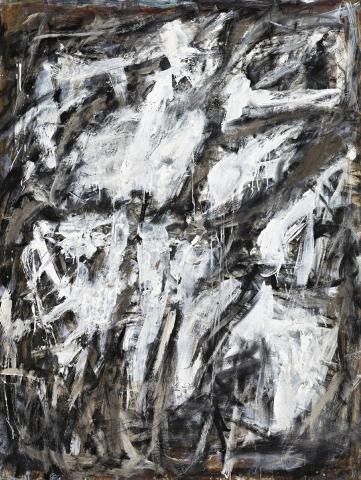TP 224, 1958-61
TONY TUCKSON
oil on composition board
122.0 x 92.0 cm
Watters Gallery, Sydney (label attached verso)
Private collection, Brisbane
Tony Tuckson: Paintings, Pinacotheca, Melbourne, 18 October - 4 November 1989, cat. 2 (illus. p. 6 in exhibition catalogue)
Tony Tuckson's paintings call upon a creativity enriched and sophisticated by his curatorial activities at the Art Gallery of New South Wales. As deputy director, he pioneered the gallery's superb collection of Australian Aboriginal and Melanesian art, then one of the finest in Australia, showing an empathy with it that had a profound influence on his own art. Yet, while influences may readily be traced to Aboriginal and European art, Tuckson was above all his own man, much of the quality of his art coming from this individuality. Reluctant to talk about his work, parallels have to be found elsewhere. Writing in the book, Australian Aboriginal Art published in 1964, Tuckson said art '... is subjective, symbolic, based on knowledge rather than visual appearances'.1 Furthermore, he believed that 'Content and form are fused by the intuitive processes of the artist', the intuitive being the way we must approach his art.2 His painting is to do with painting - the way the paint is applied, the sweep or gesture of the brush, the run or dribble, the presentation and morphing of form and colour, and so on. The way the ground shows through the painted surface, as in our painting, can add a depth or warmth that is integral to the work, as is the emotional power, inner tensions balanced or explosive, drama held in the net of the neutral blacks and whites. The absence of colour is like an understatement that says all.
Energy and passion predominate with an emotive appeal that is as captivating as it is challenging. It offers the very best in Abstract Expressionism - international as well as within Australia. The viewer is also drawn to admire the innate craftsmanship of the artist, by the way in which control is exercised during the emotional explosion of the painting's creation. Inventively powerful, the picture plane receives its due attention, while depths are conjured up through clever illusion.
1. Tuckson, J.A., 'Aboriginal Art and the Western World', Australian Aboriginal Art, Ure Smith, Sydney, 1964, p. 64, quoted in McGrath, S., 'Tony Tuckson', Art and Australia, Sydney, vol. 12, no. 2, October - December 1974, p. 164
2. Tuckson, quoted in Thomas, D., 'An Introduction to Tony Tuckson, 1921-1973, in Thomas, D., Free, R., and Legge, G., Tony Tuckson, Craftsman House, Sydney, 1989, p. 28
DAVID THOMAS
